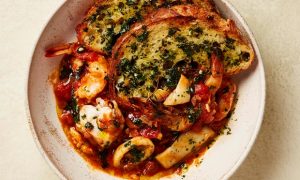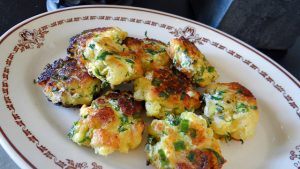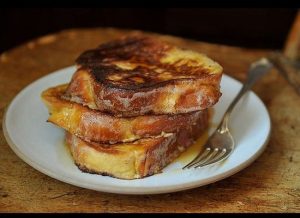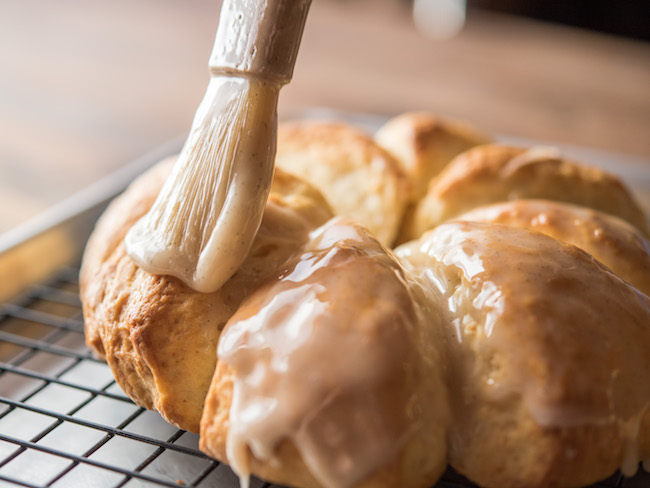Yotam Ottolenghi’s Recipes for using Up Leftover Bread
Home bakers rarely throw away bread. This makes total sense: so much effort goes into making a loaf that it’s madness to chuck out anything that doesn’t make it to the table or lunchbox before going stale. The same should apply to any bread, really: there are plenty of ways to use up leftovers, from breadcrumbs and salads to puddings and today’s “lasagne”, in which the starch in the bread soaks up the stock to create the creamy consistency of traditional lasagne. And it’s not the only trick: here are three to try.
Spicy lamb and bread “lasagne”
This is more savoury bread pudding, but the bread and cheese come together so seamlessly that it feels a lot like a lasagne in the mouth. It’s inspired by an old Sardinian dish designed to use up stale bread, but you can also use well-toasted fresh bread. I love the intense, smoky flavour of scotch bonnet, but use another type of chilli if need be, or leave it out altogether if you don’t like heat. This is a rich dish, so needs only a green salad alongside.
Prep 10-15 min
Cook 1 hr 30 min
Serves 4
3 tbsp olive oil
3 garlic cloves, peeled and crushed
2 onions, peeled and finely chopped
Salt and black pepper
800 g lamb mince
1 scotch bonnet chilli, left whole
½ tsp ground nutmeg
1 lemon, zest finely grated (i. e., 1 tsp)
3 tbsp tomato paste
150 ml dry white wine
1 litre chicken stock
30 g basil, finely chopped, plus a little extra to garnish
75 g feta, broken into 1-2 cm pieces
60 g pecorino, finely grated
5 large 1.5 cm-thick slices sourdough bread, cut in half (stale or fresh and toasted)
Heat the oven to 190C(170C fan)/375F/gas mark 5. Heat two tablespoons of oil in a large, nonstick saute pan on a medium-high flame. Add the garlic, onion and a teaspoon of salt, and fry for eight to 10 minutes, stirring often, until soft and golden.
Add the lamb, chilli, nutmeg, lemon zest and lots of pepper, and fry for 12 minutes. Don’t stir too often – you want the lamb to catch a bit on the pan, to build up a crust. Add the tomato paste, cook for two minutes, until it, too, starts to catch, then add the wine and 400ml stock. Stir, then simmer for 12-15 minutes, until thickened and reduced to the consistency of ragù. Break the chilli down into the sauce by mashing it with the back of a spoon (or remove it entirely if you prefer it less spicy).
Spread a third of the lamb mix in a thin, even layer in a high-sided, 20cm x 30cm baking dish. Scatter a third of the basil on top, followed by a third of the cheeses, then lay half the bread on top (it won’t cover the cheese entirely, but that’s OK). Repeat, then add a final layer each of meat and cheese and two of bread. Pour the remaining 600ml stock evenly over the top layer and drizzle with a tablespoon of oil.
Cover the dish tightly with foil, then bake for 20 minutes. Remove the foil and bake for 25-30 minutes more, until crisp and golden brown on top. Leave to cool for 10 minutes, then serve with some extra basil leaves scattered on top.
Seafood stew with sourdough crust
There’s nothing quite like mopping up a great fish stew with crusty bread drizzled with olive oil. Here, they’re combined in one dish.

Prep 15-20 min
Cook 50-60 min
Serves 4
220 g large, raw shell-on prawns (8-10 prawns)
135ml olive oil
4 x 100g sea bream fillets, skin removed but reserved, flesh cut into 4cm pieces (300g net weight)
1 onion, peeled and finely chopped
4 garlic cloves, peeled and finely chopped
2 tsp ground coriander
1 lemon, zest finely grated (ie, 1 tsp)
½ habanero chilli (or, if you like heat, a whole one)
Salt
1 x 400g tin chopped tomatoes
600 ml fish stock
1 squid, cleaned and cut into 2cm-thick rings (about 150g)
10g parsley leaves, finely chopped
10g basil leaves, finely chopped
280 g sourdough bread, cut into 8 1.5 cm-thin slices (leave the crusts on)
Peel the body of the prawns, but leave the heads and tails intact; reserve the shells, because you’ll be using them later. Carefully cut out and remove the vein (it’s really the intestinal tract) running along their backs, then refrigerate the prawns.
Heat the oven to 230C (210C fan)/450F/gas mark 8. Heat two tablespoons of oil in a large, nonstick frying pan on a high flame. Add the prawn shells and fish skin, and fry for four minutes, stirring occasionally, until everything is golden brown and crisp. Lift out and discard the shells and skin, and turn down the heat to medium.
Add another tablespoon of oil to the pan and, once hot, fry the onion, half the garlic, the ground coriander, lemon zest, chilli and a teaspoon of salt for four minutes, stirring often, until soft and golden.

To make the base of the stew, remove the heads and tails from three prawns, then put the prawns and four pieces of fish in the pan. Fry for three minutes, mashing the seafood with the back of a spoon. Turn the heat to medium-high, add the tomatoes and stock, and simmer for 15 minutes, until thickened; stir now and then to prevent sticking. Lift out the chilli, take off the heat and stir in all the rest of the seafood.
In a small bowl, mix the remaining garlic and oil, the parsley, basil, an eighth of a teaspoon of salt and a good grind of pepper, then brush three-quarters of this herby oil on one side of the bread slices.
Tip the stew into a high-sided, 20cm x 25cm oven dish. Lay the bread herbed side up on top and at an angle, so it overlaps, then pull up a few prawns so they peek out between the bread. Bake for 12 minutes, until the bread is crisp and golden brown. Rest for five to 10 minutes, drizzle with the remaining herb oil and serve.
Pumpernickel ice-cream with caramelised crumbs
My recipe tester Claudine Boulstridge, who doesn’t normally like the bitterness of pumpernickel, couldn’t heap enough praise on this dessert. The pumpernickel adds a unique, malty flavour that makes this ice-cream rich and complex. It’s lovely served just as it is, but also works in an affogato (ie, pour a shot of espresso over a scoop just before serving). Thanks to recipe developer Livia Brockhaus for the idea.

Prep 10 min
Cook 1 hr
Serves 4
200 ml whole milk
200 ml double cream
1 vanilla pod, slit open length ways and seeds scraped out
2 slices pumpernickel bread (155 g), lightly toasted and chopped into 3 mm chunks
4 large egg yolks
105 g dark brown soft sugar
Salt
In a medium saucepan, warm the milk, cream, vanilla pod and its seeds on a medium heat for five minutes, stirring occasionally, until the mix is steaming. Take off the heat, stir in the bread and leave to infuse for 20 minutes, stirring the mix every now and then. Strain through a fine sieve set over a bowl, and squash down the bread to extract all the milk: you should end up with about 300 ml. Reserve the vanilla pod and 75 g of the soaked bread.
Mix the egg yolks in a bowl with 65 g sugar and a pinch of salt, then stir in two tablespoons of the milk mixture. Bit by bit, add the remaining milk, stirring all the time. Rinse the pan, put the milk and vanilla pod back in, making sure you scrape in all the seeds, then cook, stirring, on medium heat for eight to nine minutes, until the custard thickens and coats the back of the spoon: don’t let it boil.

Strain the custard into a medium bowl (discard the vanilla pod). Cover with clingfilm, so it touches the surface of the custard (this will stop it forming a skin), then put to one side to cool.
Meanwhile, heat the oven to 180 C (160 C fan)/350 F/gas 4. Put the remaining 40 g sugar in a small saucepan on a high heat and cook for four minutes, stirring, until melted. Take off the heat, add the reserved bread and stir so it breaks up. Working fast, tip out on to a small oven tray lined with baking paper, and spread out thinly. Bake for 10 minutes, until browned and caramelised, leave to cool, then break into crumbs.
Once the custard has cooled, pour it into an ice-cream machine and churn for 20-30 minutes, until creamy and frozen. Stir in the breadcrumbs until they’re evenly distributed, transfer to a plastic container with a lid, and freeze for at least 30 minutes. (If you don’t have an ice-cream machine, put the mix in a freezer-proof container, cover and freeze for 20 minutes. Remove, stir to break up the crystals around the edge, and repeat until the ice-cream is a homogeneous, smooth mass. Stir in the breadcrumbs as above and freeze.) Ten minutes before serving, transfer the ice-cream to the fridge to soften slightly.’


